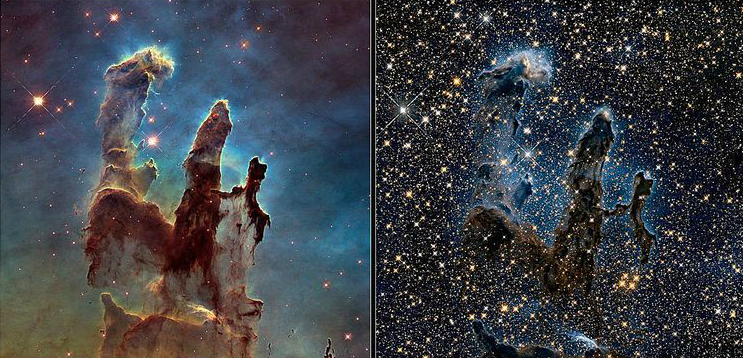There are so many incredible images of space floating around out there.
精彩纷呈的漂浮太空图片可以说是数不胜数。
But is this what space really looks like?
但太空真的长这个样子吗?
Well, kinda…
嗯,算是吧……
Let’s start with these big, sweeping images of nebulas and star-forming regions.
我们就从这些浩瀚的星云和恒星形成区的图像开始说起吧。
We can’t talk about these space images without taking a quick look at the electromagnetic spectrum.
不过,要谈这些太空图像,我们需要先快速地过一遍电磁光谱的知识。
We can only see this narrow band of visible light.
我们肉眼只能看到这一小段波长的可见光。
But on the shorter end tending towards x-rays and the longer end tending towards microwaves,
但靠近x射线一段较短的波长和靠近微波一段较长的波长,
there is still a lot of information for scientists to glean,
都还有很多信息可供科学家探究,
so they use telescopes that can see in these wavelengths that are invisible to our eye.
他们使用望远镜就可以看到我们肉眼看不到的光波。
Astronomers take that data and shift the colour information to frequencies that we can see while keeping relative colours constant.
天文学家获取到这些数据以后,会将颜色信息转换成我们能够看到的频率,同时保持颜色相对不变。
This doesn’t mean they’re not real…
但这并不意味着这些图像就不是真的了……
it’s sort of like changing the key of a song — it sounds different but still the same.
就好比换一个音高唱同一首歌一样——听上去是会有些不同,但歌还是那首歌。
Let’s take Hubble as an example.
我们就以哈勃望远镜为例。
Hubble can see in visible light like we can, but using specialize instruments it can also see in ultraviolet and infrared light.
哈勃和我们一样能看到可见光,但配备特殊仪器也能看见紫外光和红外光。
Light information hits the digital camera sensor as a greyscale image -- yep, those amazing hubble images have no color.
数码相机传感器能够以灰阶图像的形式捕捉到光线信息——是的,那些神奇的哈勃图像是没有颜色的。
Then astronomers add colour data and adjust for known wavelengths,
之后,天文学家给那些图像加上颜色数据,调整成对应的已知波长,
adding corresponding colours and patching different shots together to give a complete picture.
加上相应的颜色,再将同系列的照片整合到一起就能形成一张完整的图像。
A great example is these two images of the Pillars of Creation…
这两张创生之柱的图像就是很好的例子……
three columns of cold gas in a star-forming region of the Eagle Nebula.
创生之柱即鹰状星云这一恒星形成区内的三个冷气体柱。
The one on the left is seen in visible light and the one on the right is seen in infrared light.
左边那张图是转化成可见光之后的图,右边那张则是红外光下的图像。
Looking in the infrared, Hubble could see through the gas and dust -- that blocks our vision -- to show stars forming inside the pillars.
通过红外线,哈勃可以透过阻挡我们视线的气体和尘埃,看到正在柱子内部慢慢成形的恒星。
So space sort of looks like both of these images, but it also doesn’t…
所以,太空看似和这两幅图像都有点像,但也不像……
it takes processing and adding colour data to get this kind of rich detail.
因为需要处理和上色才能获得如此丰富的细节。
But there’s another type of space image: the artist’s rendering.
不过,还有一种太空图像:艺术家渲染的太空图像。

These are some of the most exciting images, and also the ones that demand the most guesswork.
这种图像最振奋人心,需要想象的空间也最大。
Let’s take this image of Trappist-1f as an example.
我们就以特拉普斯特-1f的图像为例。
Trappist-1f is part of the Trappist-1 system, we have a video on it.
特拉普斯特-1f是特拉普斯特-1系的一部分,我们还专门做了一期视频将这个星系。
So, how do we know what the surface looks like?
那么,我们怎么知道它的表面长什么样子的呢?
Well, we don’t. Because this is what the data looks like.
嗯……并不知道。因为这就是数据原来的样子。
But artists consulted with scientists to make this image.
但艺术家们在制作这幅图像之前咨询了科学家。
First, astronomers used the Spitzer telescope to estimate of the mass of the planet, and its density;
首先,天文学家通过斯皮策望远镜估算出行星的质量和密度,
from this information, the scientists figured out that 1f is likely a rocky planet.
根据这些信息,科学家们推断出,特拉普斯特-1f可能是一颗岩质行星。
Then, from transit measurements, astronomers know the planet orbits close to its star, way closer than Mercury does our Sun,
然后,通过凌日观测法,天文学家了解到,这颗行星的轨道离它的恒星很近,比水星离太阳还近得多,
so the star would look big in the sky.
所以,它在天空中看起来就很大。
But that star is an ultra-cool dwarf, so it’s possible for liquid water to exist on the surface of the planet!
但特拉普斯特-1f的恒星是一颗超低温矮星,所以,特拉普斯特-1f行星表面是可能有液态水存在的!
So they put that in the image too.
所以他们将这一点也放到了这张图里。
And, finally, because the other planets in the system orbit close to 1f, the scientists think you might be able to see them in the sky.
最后,因为系统中其他行星的轨道也很接近1f,所以,科学家们认为,大家或许能在天空中看到它们。
Et voila! An artist’s rendering of Trappist-1f.
嗒哒!艺术家对特拉普斯特-1f的渲染就出来啦。
Look’s nice.
貌似不错呢。
So, even if these images aren’t exactly what we’d see if we were to visit the Pillars of Creation (which are gone now, by the way) or Trappist-1f…
所以,即便这些图像和我们实地参观创世之柱(顺便说一句,现在已经没有了)或特拉普斯特-1f时看到的并不完全一样……
These images not only give us vital information, they kind of remind us how exciting it is to find new things in space.
这些图像不仅为我们提供了重要的太空信息,还提醒着我们,在太空中有新发现是多么激动人心的一件事情。


